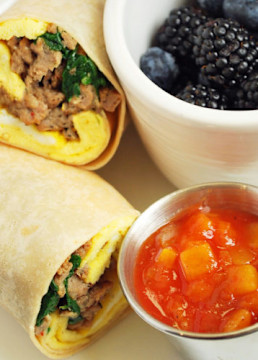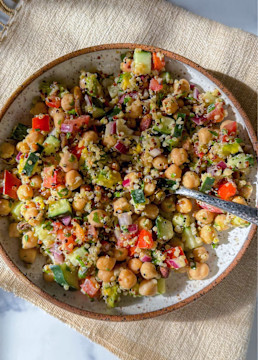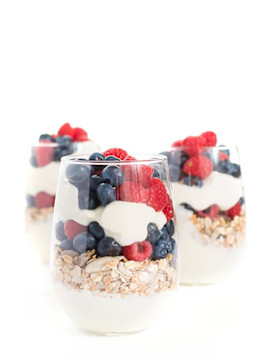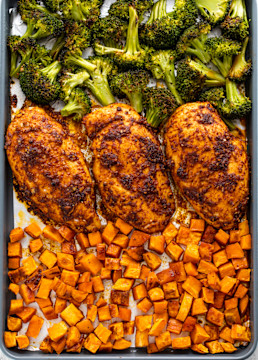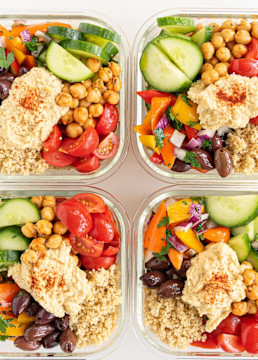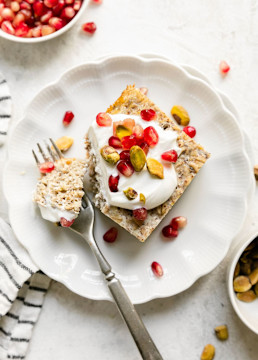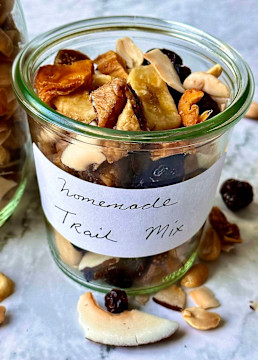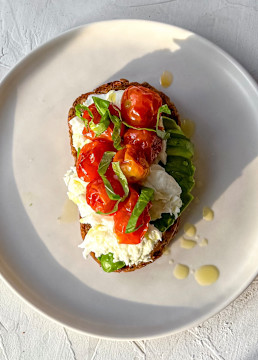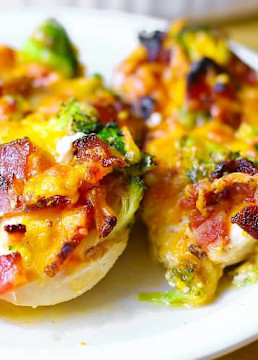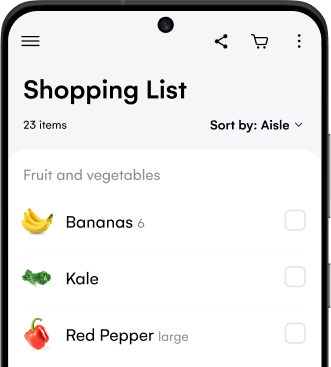Trying to gain weight, especially if you’re unsure what to eat, can be a struggle. Often, people turn to high-calorie and low nutrition foods, which isn’t the safest or heathiest way to go about weight gain. If you’re looking for inspiration, we’ve made a 7-day weight-gain meal plan that may help you put on weight healthily and sustainably.
If you’re not sure what this meal plan is all about or why you’d need it, you can read through this section first, and go back to the meal plan below when you’re ready. If you want to see what meals and recipes are waiting for you, carry on reading!
7-day Weight-Gain Meal Plan
The weight gain meal plan below is based on the following nutrition requirements:
- 2,400 calories
- 270 g of Carbohydrates
- 150 g of Protein
- 80 g of Fat
Note: Nutritional requirements may differ from one person to another. Factors such as your age, sex, height, weight, physical activity, medical condition, and nutrition/health goal, should be considered when calculating your daily nutrition requirements. Please consult a dietitian before making drastic changes to your diet.
This meal plan also includes some repetition of recipes and food combinations throughout the week. Why? This meal plan was designed for people who want to save time and resources in preparing their meals, which means repeating some recipes and making full use of your ingredients. You can check this table to see which recipes will be repeating throughout the week so you meal prep enough servings.
Day 1 is usually the same day as your meal prep for the whole week. Alternatively, you can choose to do the meal prep before you start the meal plan.
Here are some meal prep tips:
Easy Low-Carb Breakfast Burritos (Day 1 and 3): Cook fillings in advance, assemble burritos, and freeze; reheat directly when needed.
15-Min Chickpea Quinoa Salad with Cumin Tahini (Day 1 and 3 Lunch, Day 5 Dinner): Cook quinoa and chickpeas ahead; refrigerate and toss with dressing fresh.
Lime Marinated Grilled Chicken (Day 1 and 3 Lunch, Day 5 Dinner): Marinate and grill in advance; freeze portions and reheat as needed.
- To meet a 2400-kcal recommendation:
For Lunch: Pair your quinoa salad with a serving of Lime Marinated Grilled Chicken (Approximately 290 calories)
For Dinner: After your meal, enjoy a refreshing dessert and have a fresh fruit salad (Approximately 144 calories)
Here are some meal prep tips:
Pumpkin Spice French Toast (Day 2 and 6): Pre-cook slices and freeze in layers with parchment paper; reheat in toaster or oven.
Classic English Scrambled Eggs (Day 2, 4, and 7): Pre-crack eggs and refrigerate for up to 2 days; cook fresh for the best texture.
- To meet a 2400-kcal recommendation:
For Breakfast: For breakfast, add some protein to your meal with a serving of classic English scrambled eggs (Approximately 236 calories).
For Dinner: To complete your meal, pair your salmon with a quinoa avocado spinach salad (Approximately 220 calories per serving).
Day 3 is similar to Day 1’s meal plan.
Here are some meal prep tips:
Homemade Trail Mix (Day 3 and 5 Snacks): Mix ingredients and portion into bags; store in an airtight container.
One-Pan Roasted Chicken, Broccoli & Sweet Potato (Day 1, 3, and 6 Dinner): Roast everything in bulk; refrigerate for up to 3 days or freeze.
- To meet a 2400-kcal recommendation:
For Breakfast: Start your day with a delicious blueberry smoothie to pair with your breakfast (Approximately 170 calories).
For Lunch: Similar to Day 1, pair your quinoa salad with a serving of Lime Marinated Grilled Chicken (Approximately 290 calories)
For Dinner: Like in Day 1, enjoy a refreshing dessert after your meal and have a fresh fruit salad (Approximately 144 calories)
Day 4 is similar to Day 2’s meal plan, but with a different breakfast. Today we’re going to start the day with some quick and easy oats, and some additional food combinations!
Here are some meal prep tips:
Roasted Tomato Mozzarella Avocado Toast (Day 4 and 7): Roast tomatoes ahead and refrigerate; toast bread and assemble fresh.
Broccoli Bacon Cheddar Chicken (Day 4 and 6 Lunch): Pre-cook components, assemble, and refrigerate; reheat before serving.
- To meet a 2400-kcal recommendation:
For Breakfast: Pair your breakfast with some classic scrambled eggs. (Approximately 236 calories).
For Day 5, we’re going to change it up a bit with your egg and avocado open sandwich for breakfast!
Here are some meal prep tips:
Baked Salmon in Foil (Day 2 Dinner, Day 5 Lunch): Bake salmon, portion, and freeze; thaw overnight and reheat.
Quinoa Avocado Spinach Salad (Day 2 Dinner, Day 5 Lunch): Cook quinoa and refrigerate; add avocado fresh when assembling.
- To meet a 2400-kcal recommendation:
For Breakfast: Start your day with a delicious blueberry smoothie to pair with your breakfast (Approximately 170 calories).
For Lunch: Like your dinner on Day 2, complete your lunch by pairing your salmon with a quinoa avocado spinach salad (Approximately 220 calories per serving).
For Dinner: Similar to Day 1 and 3, pair your quinoa salad with a serving of Lime Marinated Grilled Chicken (Approximately 290 calories)
Day 6 has a couple of recipe repetitions but with some interesting new combinations!
Here are some meal prep tips:
Baked Vanilla Protein Oatmeal Breakfast Bars (Day 2, 4, and 6 Snacks): Bake ahead, cut into bars, and refrigerate; freeze for longer storage.
Fresh Fruit Salad (Day 1 and 3 Dinner, Day 6 Lunch): Chop fruits ahead and toss with lemon juice; store in the fridge for up to 2 days.
- To meet a 2400-kcal recommendation:
For Lunch:Your lunch deserves some dessert and additional fiber, so a refreshing serving of fresh fruit salad will do the trick! (Approximately 138 calories).
End your week strong! We’ve got some recipe repetitions with one new recipe recommendation for Day 7 of this weight gain meal plan!
Here are some meal prep tips:
Greek Yogurt Muesli Parfaits (Day 1 and 7 Snacks): Layer yogurt and fruit in jars; add granola fresh to keep it crunchy.
Mediterranean Lunch Box (Day 2, 4, and 7 Dinner): Chop veggies and assemble in containers; store dressings separately to maintain freshness.
- To meet a 2400-kcal recommendation:
For Breakfast: For breakfast, add some protein to your meal with a serving of classic English scrambled eggs (Approximately 236 calories).
Note: Consult with a dietitian about your calorie and nutrient needs – especially when planning a weight-gain meal plan. This means you’ll gain weight safely while also getting enough nutrients for your body to function at its best.
Ingredient and Shopping Tips
We’re all about saving time, money, and making your eating habits work for you. So, here are some additional tips to help turn this meal plan into reality:
- Start meal planning your high protein meal plan and grocery list on Friday and Saturday. Do your shopping over the weekend.
- Pay attention to nutrition labels. Even though you’re trying to gain weight, you still have to be aware of the quality of food you’re eating. Aim for foods who have lower saturated fat, lower sodium content and high fiber content. Avoid products with added sugars, unhealthy fats, and artificial ingredients.
- Use herbs, spices, and natural flavorings to add flavor to your meals without relying too much on added sugars, salt, or unhealthy fats.
Below, we’ve listed meals where you’ll need to prepare two or three servings in this weight gain meal plan. Make sure to store them in separate, airtight containers and to refrigerate them.
| Recipes | Number of servings to prepare | Day and meal planned |
| Easy Low-Carb Breakfast Burritos | 2 servings | Day 1, and 3 Breakfast |
| Pumpkin Spice French Toast | 2 servings | Day 2 and 6 Breakfast |
| Egg & avocado open sandwich | 2 servings | Day 5 and 7 Breakfast |
| Classic English scrambled eggs | 3 servings | Day 2, 4 and 7 Breakfast |
| Roasted Tomato Mozzarella Avocado Toast | 2 servings | Day 4 and 7 Breakfast |
| Blueberry smoothie | 2 servings | Day 3 and 5 Breakfast |
| Baked Salmon in Foil | 2 servings | Day 2 Dinner, and Day 5 Lunch |
| Quinoa avocado spinach salad | 2 servings | Day 2 Dinner, and Day 5 Lunch |
| Lime Marinated Grilled Chicken | 3 servings | Day 1 and 3 Lunch, and Day 5 Dinner |
| 15 min Chickpea Quinoa Salad with cumin tahini | 3 servings | Day 1 and 3 Lunch, and Day 5 Dinner |
| Mediterranean Lunch Box (Meal Prep) | 3 servings | Day 2, 4 and 7 Dinner |
| Broccoli Bacon Cheddar Chicken | 2 servings | Day 4 and 6 Lunch |
| Greek Yogurt Muesli Parfaits | 2 servings | Day 1 and 7 Snacks |
| Baked Vanilla Protein Oatmeal Breakfast Bars | 2 servings | Day 2, 4 and 6 Snacks |
| Homemade Trail Mix | 2 servings | Day 3 and 5 Snacks |
| One-Pan Roasted Chicken, Broccoli & Sweet Potato | 3 servings | Day 1, 3 and 6 Dinner |
| Fresh fruit salad | 3 servings | Day 1, and 3 Dinner and Day 6 Lunch |
What is a Weight-Gain Meal Plan?
A weight-gain meal plan involves eating in a calorie surplus; when you consume more calories than your body burns. This surplus provides the energy required for the body to build new tissues and store energy.
What you should know
When people think of gaining weight, they often think of chocolates, chips, doughnuts, and takeaways. And sure, a weight gain meal plan does involves eating excess calories, so you’re in a surplus. But actually, it’s not about eating unhealthy meals all the time or getting all your extra calories from sugar, saturated fats, and heavily processed foods. Rather, the foods on your weight gain meal plan should still be nutrient-dense foods that provide a balance of macronutrients (carbohydrates, proteins, and fats) and micronutrients (vitamins and minerals).
Who may benefit from a weight-gain meal plan?
This meal plan can be helpful for people who are/have:
- Underweight: If your Body Mass Index (BMI) is below the normal range (18.5-24.9 for adults).
- Athletes and Bodybuilders: A weight gain meal plan can provide the necessary nutrients to support intense training, muscle building, and muscle recovery.
- High Metabolism: Individuals with a naturally high metabolism often burn calories quickly and may struggle to gain weight despite eating large quantities of food.
- Specific Medical Conditions: hyperthyroidism, digestive disorders, or those undergoing chemotherapy may have higher calorie requirements to help support their medical conditions.
Reminder: It is important to consult a healthcare professional if you fall into any of these categories. A healthcare provider can offer personalized advice and ensure that your meal plan is safe and effective for your specific health needs.
How many calories should I eat to gain weight?
The number of calories required can vary based on several factors, including your current weight, age, sex, activity level, and metabolic rate.
Additional reminders:
- To gain weight, you need to consume more calories than your TDEE (Total Daily Energy Expenditure).
- A safe and effective rate of weight gain is about 0.5 to 1 pound per week. This generally requires a caloric surplus of about 250-500 calories per day above your TDEE.
- Incorporating strength training exercises can help you build muscle mass as you gain weight. Exercise also supports overall health and can improve your energy levels and physical performance.
FAQs on Weight-Gain Meal Plan
Most junk food is high in calories, but not recommended as a regular part of your weight gain meal plan. This type of food usually lacks essential nutrients. Of course you can incorporate junk food inn moderation, but it shouldn’t make up the majority of your diet.
A weight-gain diet typically has more calories than you’re used to eating. So you can spread your meals to 5-6 times a day, with three of the meals being your main meals and the rest being snacks*.
*5-6 meals isn’t a requirement. It can still vary depending on your appetite, schedule, and personal preferences.
